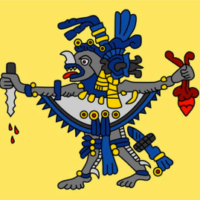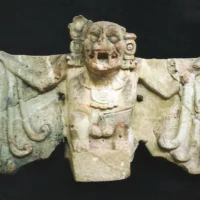Camazotz : The Bat God
Listen
At a glance
| Description | |
|---|---|
| Origin | Mayan Mythology |
| Classification | Gods |
| Family Members | N/A |
| Region | Mexico, Guatemala, Belize, Honduras, and El Salvador. |
| Associated With | Underworld, Flight, Death |
Camazotz
Introduction
Camazotz is a significant deity in Mayan mythology, closely linked to the Popol Vuh, the sacred text of the K’iche’ Maya. Often depicted as a bat or a figure with a human body and a bat’s head, Camazotz embodies the duality of life and death, a recurring theme in many mythological traditions. His association with the night, the underworld, and sacrifice underscores the complex relationship between humans, nature, and the spiritual world in Mayan culture. While Camazotz’s fearsome presence and connection to death might suggest malevolence, he is instead viewed as a necessary force in maintaining the balance of the universe.
Physical Traits
Camazotz is most commonly depicted as an anthropomorphic figure with a bat-like head, characterized by large, pointed ears, a sharp snout, and fangs. His human-like body is often adorned with elaborate clothing and jewelry, symbolizing both his regal and fearsome nature. The dark colors used in his imagery, typically black or brown, underscore his connection to the night and the underworld. Camazotz’s wings are expansive and leathery, allowing him to glide through the darkness, and his depiction sometimes includes claws and talons, highlighting his predatory aspect. The bat symbolism in Mesoamerican culture links Camazotz to themes of death, darkness, and the afterlife, reflecting societal fears and beliefs about mortality. His dual nature, both demonic and regal, illustrates the complex roles he plays in Mayan mythology, embodying the unpredictability of life and the inevitability of death.
Family
In Maya mythology, Camazotz’s associations with other deities and figures reflect his integral role within the mythological framework. Though his familial connections vary across different accounts, Camazotz is often linked with creator deities and those involved in the underworld. He is sometimes depicted as a servant or companion to the goddess of death, highlighting his role in maintaining cosmic balance between life and death. Additionally, his interactions with deities such as Ixchel, the goddess of the moon and childbirth, and Hun Batz, a god associated with the night and sacrifice, further emphasize his complex relationships within the pantheon.
Chac, the god of rain and thunder, is occasionally portrayed as a rival to Camazotz, symbolizing the eternal conflict between light and darkness. Unlike many other Mayan deities, Camazotz is not clearly linked to a specific family lineage. Instead, he is often depicted as a solitary guardian of the underworld, interacting with the Xibalbans and other dark entities. This lack of defined familial ties underscores his role as a powerful, independent figure within the mythological landscape.
Other names
Camazotz is recognized by various names and titles across different Mayan communities. While commonly known as “Death Bat,” he is also referred to simply as “Camazot,” a name that preserves his core identity across cultural contexts. Additionally, he is linked to “K’uk’ulkan,” reflecting associations with feathered serpents, though this name highlights his connection to specific regional beliefs.
In inscriptions and artifacts, Camazotz appears under different names, showcasing the localized interpretations and worship practices within the Maya civilization. Variations such as “Zotz” and “Cacaloch” denote his bat-like nature in various Mayan languages. Other forms of his name include “Cama-Zotz,” “Sotz,” and “Zotz,” which are adaptations across different dialects. Despite these linguistic differences, Camazotz’s fundamental attributes and mythological significance as a deity connected to death and the underworld remain consistent.
Powers and Abilities
In Mayan mythology, Camazotz is endowed with a range of formidable powers that underscore his role in the pantheon. His primary domain includes death, the underworld, and the transition between life and the afterlife. Camazotz’s association with bats highlights his mastery over darkness and shadows, symbolizing his deep understanding of the mysteries surrounding life and death.
His abilities extend beyond mere death; they encompass themes of transformation and the cyclical nature of existence. Camazotz is known for his capacity to instill fear and chaos, often depicted as swooping from darkness to claim his victims. His power of flight, facilitated by his bat-like wings, allows him to traverse both the night sky and the underworld.
In the Popol Vuh, Camazotz is described as having the lethal ability to decapitate his enemies with a single blow. He is also reputed to control other bats and nocturnal creatures, directing them as part of his dominion over the night. His connection to caves, seen as portals to the underworld, further emphasizes his role as a guide and guardian of the realms beyond death.
Modern Day Influence
Camazotz’s legacy extends into contemporary culture, where he is frequently incorporated into various creative and academic fields. His fearsome persona and symbolic connection to bats continue to influence literature, film, and video games, often representing themes of darkness and the supernatural. For instance, Camazotz is featured in horror and fantasy genres, where his character is reimagined to fit modern storytelling.
In addition to his presence in popular media, Camazotz remains significant in some indigenous Mayan communities, where rituals and ceremonies connected to him continue to be practiced. This ongoing reverence highlights the deity’s role in preserving cultural heritage and connecting present-day communities with their ancient traditions.
Academically, Camazotz is a subject of interest for scholars studying Mesoamerican mythology and culture. Research into his role in texts like the Popol Vuh provides insights into ancient Maya beliefs and practices, and the symbolic role of bats in Mesoamerican art and mythology is examined in scholarly studies. Overall, Camazotz’s impact is evident not only in modern creative expressions but also in the enduring cultural and spiritual practices of indigenous communities, reflecting the deep-rooted influence of this mythological figure.
Related Images
Frequently Asked Questions
What is lorem Ipsum?
I am text block. Click edit button to change this text. Lorem ipsum dolor sit amet, consectetur adipiscing elit. Ut elit tellus, luctus nec ullamcorper mattis, pulvinar dapibus leo.
What is lorem Ipsum?
I am text block. Click edit button to change this text. Lorem ipsum dolor sit amet, consectetur adipiscing elit. Ut elit tellus, luctus nec ullamcorper mattis, pulvinar dapibus leo.
What is lorem Ipsum?
I am text block. Click edit button to change this text. Lorem ipsum dolor sit amet, consectetur adipiscing elit. Ut elit tellus, luctus nec ullamcorper mattis, pulvinar dapibus leo.
What is lorem Ipsum?
I am text block. Click edit button to change this text. Lorem ipsum dolor sit amet, consectetur adipiscing elit. Ut elit tellus, luctus nec ullamcorper mattis, pulvinar dapibus leo.
What is lorem Ipsum?
I am text block. Click edit button to change this text. Lorem ipsum dolor sit amet, consectetur adipiscing elit. Ut elit tellus, luctus nec ullamcorper mattis, pulvinar dapibus leo.











